Internet Video Use Rises
The Pew Internet & American Life Project released a report this week entitled “Online Video 2013” that CTIA was happy to tweet about under their “FunFactFriday” hashtag as part of their never ending feud with NAB.
The Poynter Institute, an international strategy center and a leader in journalism education, posted the following chart of one of the report’s key findings of the report:
Note that this is similar, but stronger, than the “zero TV” data reported a few months ago by that archenemy of broadcasting, CBS News.
Note that this trend is also related to the NAB/CEA feud over how many homes even have an antenna to watch over-the-air (OTA) DTV.
So if FCC ever become functional and if the incentive auction can be done on schedule with the unexpected delay, parties may wish to consider the long time viability of the classic TV broadcasting model and the statement of Mr. Justice Alito, previously reported here.

For the record, your blogger believes that there is a future for TV broadcasters and even OTA DTV, but it is very different than the one that NAB publicly describes.
Spectrum Lessons from the 2013 Emmys
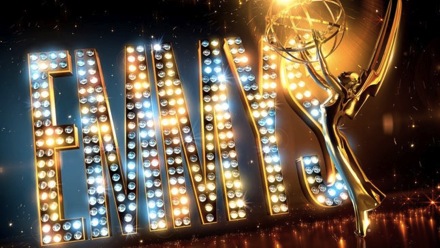
As NAB engages in arguments with others about how many homes actually watch over-the-air (OTA) television, this week’s Emmy’s demonstrate some of the real problems the TV broadcast establishment is having with their nonspectrum-based competition for the hearts and minds of America.
Consider the outstanding series/program categories of awards:
- Outstanding Comedy Series - Modern Family (ABC)
- Outstanding Drama Series - Breaking Bad (AMC)
- Outstanding Variety Series - The Colbert Report (Comedy Central)
- Outstanding Miniseries or Movie - Behind the Candelabra (HBO)
- Outstanding Reality - Competition Program - The Voice (NBC)
Also consider the outstanding actor/actress awards:
- Outstanding Lead Actor in a Comedy Series - Jim Parsons as Dr. Sheldon Cooper on The Big Bang Theory (Episode: "The Habitation Configuration") (CBS)
- Outstanding Lead Actress in a Comedy Series - Julia Louis-Dreyfus as Selina Meyer on Veep (Episode: "Running") (HBO)
- Outstanding Lead Actor in a Drama Series - Jeff Daniels as Will McAvoy on The Newsroom (Episode: "We Just Decided To") (HBO)
- Outstanding Lead Actress in a Drama Series - Claire Danes as Carrie Mathison on Homeland (Episode: "Q&A") (Showtime)
- Outstanding Lead Actor in a Miniseries or Movie - Michael Douglas as Liberace on Behind the Candelabra (HBO)
- Outstanding Lead Actress in a Miniseries or Movie - Laura Linney as Cathy Jamison on The Big C: Hereafter (Showtime)
Thus in voting by TV industry insiders (not the antibroadcast types at CEA or even CTIA), OTA TV won only 2 out of 5 outstanding program/series awards and only 1 out of 6 outstanding actor/actress awards. Note that HBO alone got more of these awards than ALL of the traditional OTA networks! Sounds like today’s OTA TV is having trouble capturing the audiences it used to get. Maybe it can do better?
Or maybe the whole OTA TV business model is now flawed?
I was interested to read several times that Netflix has outbid its competitors for new popular programming. One reason could be that Netflix has a vast database of user preference information compared to what OTA TV execs have. This allows Netflix to predict the success of new programming better and thus outbid networks and other video providers. GigaOm has written
Netflix didn’t have to spend millions of dollars advertising the new show hoping you would tune in — it knew you’d see it in the recommendations, it knew you’d give it a try and it knew you’d like it.

Together, the major broadcasters account for more than 21 percent of prime-time viewing in the current TV season, down from almost 75 percent in the early 1950s, before cable programmers emerged, according to Nielsen data.
Recently we stayed with a real “millennial” who had 15 Mbps service from Comcast, 2 computers, but no TV and no cable subscription either. For video she relied on Amazon, not the NAB membership. Time will tell how this trend evolves, but it probably should affect spectrum policy decisions in urbanized areas particularly if we can develop mechanisms to replace “free TV’ with universal video service. Actually the National Broadband Plan basically had that but it was too controversial with broadcasters to emphasize.
NAB: "CA lawmakers to FCC: Protect viewers (from our members) during incentive auctions"
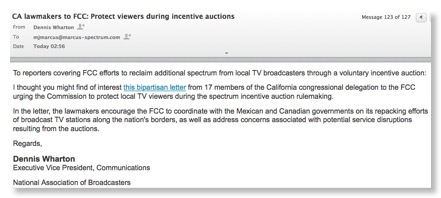
As part of its continuing disinformation campaign about the FCC’s incentive auction that was approved by Congress over NAB’s strenuous objection (impossible a decade ago when NAB was much more powerful at FCC and on the Hill - sic transit gloria mundi), NAB’s Dennis Wharton just sent out the above message. The message deals with a letter from California congressmen, no doubt instigated by NAB.
The letter basically says that the FCC incentive auction NPRM did not ask enough questions. For the record, the 189 page NPRM (not counting statements by commissioners) has 260 poorly organized questions.
(This is a general problem of FCC NPRMs and results from the internal coordination process where all sorts of people from the 8th Floor down can add questions or can be “bought off” with adding a question to silence some concern. I note that procurement requests for proposals (RFPs) by military agencies are as thick as NPRMs. ask for replies by outside parties, but have much better organized questions. However FCC is so insular and believing in its own exceptionalism that it has no interest to organize its questions better or to even number them!)
So will the NAB disinformation campaign continue? Of course just as NAB’s first response to Hurricane Sandy was not to brag, rightfully, about broadcaster performance during the storm but rather “dis” the cellular industry. Below are some recent NAB tweets from @AirWharton on their ongoing battle with the cellular industry.
Note that NAB has been so technically unsavvy and behind the times that they use @AirWharton on Twitter because they don’t have any Twitter accounts using “NAB”, which belongs to National Australia Bank, whereas the more technically savvy and up to date CTIA certainly has @CTIA.
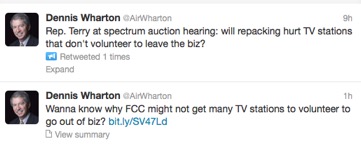
NAB/CTIA Hurricane Sandy Twitter Feud
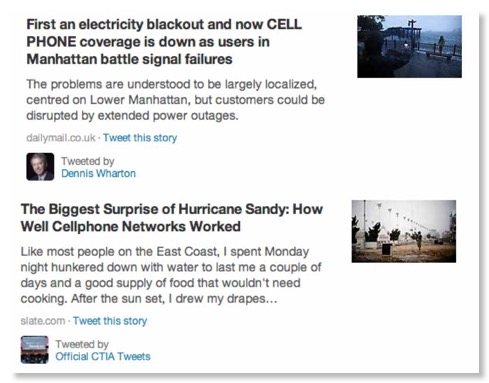
While the East Coast recovers from Hurricane Sandy, the PR forces at both NAB and CTIA are using the occasion for a Twitter war to take advantage of people’s misery, not doubt with an eye on the pending incentive auctions. The above 2 tweets showed up in my Twitter Digest. The top tweet from NAB’s Dennis Wharton, Executive VP, Media Relations, links to this Reuters article entitled “Hurricane Sandy disrupts Northeast U.S. telecom networks” which includes the line “Cellphone service was spotty for top wireless providers Verizon Wireless, AT&T Inc and T-Mobile USA, a unit of Deutsche Telekom, according to some customers.” However the article did not focus on cellphone issues and dealt with wirelines, CATV, and cellular issues.
The “Official CTIA Tweet” links to this Slate article entitled “The Biggest Surprise of Hurricane Sandy: How Well Cellphone Networks Worked”. This article contrast dramatically with the article on the front page of today’s WSJ “After Sandy, Wired New Yorkers Get Reconnected With Pay Phones:Coin-Eating Retro Devices Baffle Some, Frustrate Many; Moment Merits a Tweet”
Like the terrorist attacks of 2001 and the blackout of 2003, Sandy has exposed the limitations of the cellphone. Not only does it require electricity for charging, but the cellphone also won't pick up service if a major storm has knocked out the telecommunications infrastructure that provides reception.
Apparently no one really knows quantitatively how well the cell phone networks are doing post-Sandy. Cnet.com reports:
Genachowski said that as of 10 a.m. ET today, 25 percent of the nation's wireless companies' cell sites were not operational in 158 counties in 10 states from Virginia to Massachusetts. This information comes from the carriers themselves, which report outages to the FCC as part of the agency's Disaster Information Reporting System (DIRS).Genachowski and David Turetsky, who is the FCC's public safety and home security bureau chief, explained that the number of cell sites and cable customers without service was greater in areas where there has been more storm damage. And they emphasized that the storm is still ongoing as it travels westward to states such as Michigan. And they are expecting more disruptions as the storm progresses.
The officials wouldn't comment specifically on how many wireless customers have been affected by the outages. But they said service is likely to get worse for customers before it gets better. Even customers who may have service now in some affected areas could be without it in the coming days as backup batteries run out of power.
The main issue affecting the restoration of service to cell sites is the fact that commercial power may be out for several days or even weeks in some areas. Between 7 million to 8 million people are reportedly without power in areas affected by the hurricane, officials said.
Some cell sites have already been running on backup power. But the FCC was unable to say exactly how many. Still, the commercial power issues mean that these sites could also go down in the next day or so, especially if repair crews are unable to get to sites that need battery replacements and generators that need refueling.
HuffPo has a similar report.
CTIA’s Chris Guttman-McCabe, Vice President, Regulatory Affairs, was on NPR this morning defending CTIA’s court appeal to block the post-Katrina FCC emergency power rule. Harold Feld, who was also on NPR this morning, describes this issue in a post entitled “If your cell tower loses power, be sure to thank CTIA and the D.C. Circuit”
CTIA and NAB: This is not the time to be name calling or be defensive of past actions. Please stop your Twitter war. Let’s focus on restoring service and on how to make communications policy more responsive to national needs, not just the near term problems of your industry.
UPDATE
The November 2 WSJ has an article entitled “Outages Expose Wireless Carriers' Backup Plans”.
Some interesting quotes:
Regulators and phone companies have sparred since Hurricane Katrina over how best to ensure the resiliency of wireless networks. The industry has largely won, for example, fighting back regulations that would have required backup power at cell towers. …
Wireless carriers have released little data this week to allow broader conclusions to be drawn of how the networks are holding up in various locations. While electric utilities publish regular updates on the number and location of customers without power, carriers have made only vague statements about the state of their networks. …
Carriers say they've worked in recent years to make their networks more reliable, installing more secure infrastructure and redundant communications paths. But in Washington, they have fought efforts to make them more accountable in disasters. After widespread cellphone outages in the aftermath of Hurricane Katrina, the FCC tried to require wireless carriers to install backup batteries at all of their sites. Carriers sued to block the rule, and the government eventually dropped its attempt to implement it. …
Last year, the FCC proposed that the industry explore wireless networks that can be operated from blimps and unmanned aircraft in a disaster. The wireless industry pushed back, arguing such systems would cause interference. Wireless carriers argue they don't need rules to ensure the reliability of their networks, because it's in their best interest to do so. …"We're pulling up the safety net behind us, and we don't have a new safety net in case something goes wrong," said Harold Feld, legal director for consumer group Public Knowledge.
It isn’t often when the WSJ is sympathetic with the Genachowski FCC and quotes Harold Feld and not the CTIA staff.
Let me also recommend the evolving discussion of the above article on the WSJ site which contains a variety of view points on this issue, some supportive of the industry, some not.
CTIA leadership, you can impress your membership by winning this type of court cases, but is it really worth it? Is it really in the interest of your members or the public?
UPDATE 2
On November 2, the NY Times, which rarely agrees with WSJ on anything, published an article on cellphone outages entitled “Steaming at Hit-or-Miss Service” -- also quoting Harold Feld.
In an emergency, a lack of cellphone reception can be dangerous, especially as more people have chosen to snip landlines out of their budgets. About 60 percent of American households have landlines, down from 78 percent four years ago, according to Chetan Sharma, an independent mobile analyst. …
“With the new networks we’ve prized keeping costs down, we’ve prized flexibility and we’ve prized innovation,” said Mr. Feld, who wrote a blog post on Monday anticipating cell tower problems. “But we have not put stability as a value when we have been pushing to have these networks built out.”
Mr. Feld noted that after Hurricane Katrina in 2005, the F.C.C. recommended that carriers install backup batteries on their transmission towers that would last 24 hours, among other measures. But the carriers objected, presumably because they did not want to spend the money, he said. (Of course, 24 hours would not have been enough in many areas hit by the latest storm.)
In general, the carriers say it is in their own interest to fortify their networks for emergency situations, but Mr. Feld said this incentive was not enough.
The unreliability of wireless networks may point to a bigger problem. Over the years, the phone companies have fought off regulators who want to treat them as utilities, arguing that if they are going to stay innovative, they cannot be burdened with the old rules that phone companies dealt with in the landline era. But as a consequence, there are almost no rules about what carriers have to do in an emergency, said Harold Feld, senior vice president for Public Knowledge, a nonprofit that focuses on information policy.

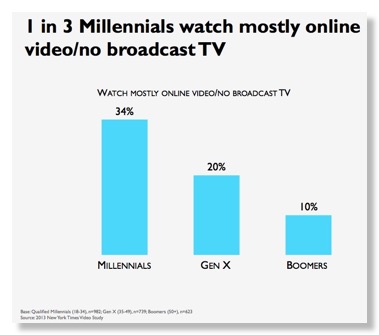
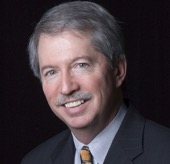



![Validate my RSS feed [Valid RSS]](valid-rss-rogers.png)

